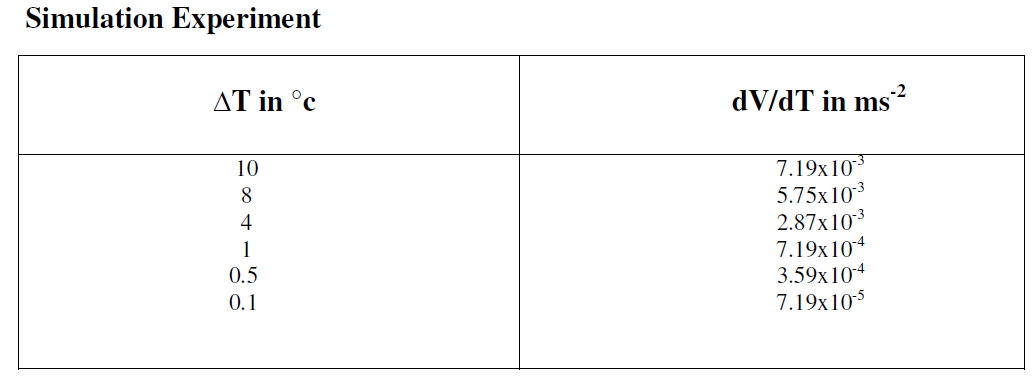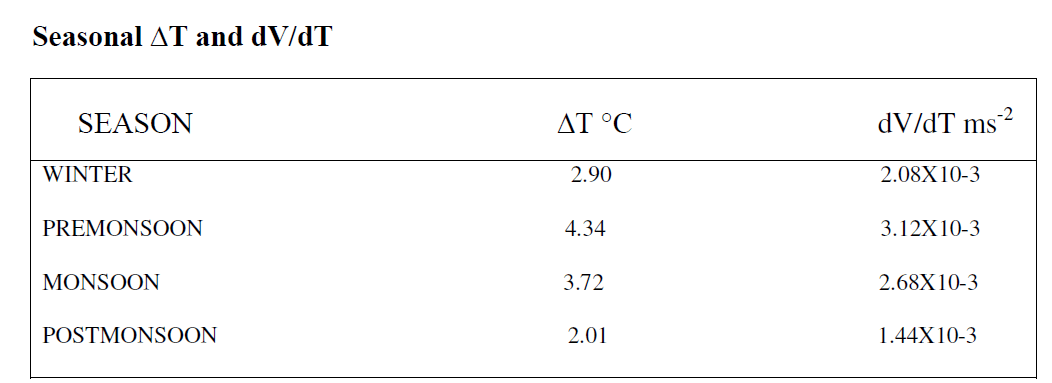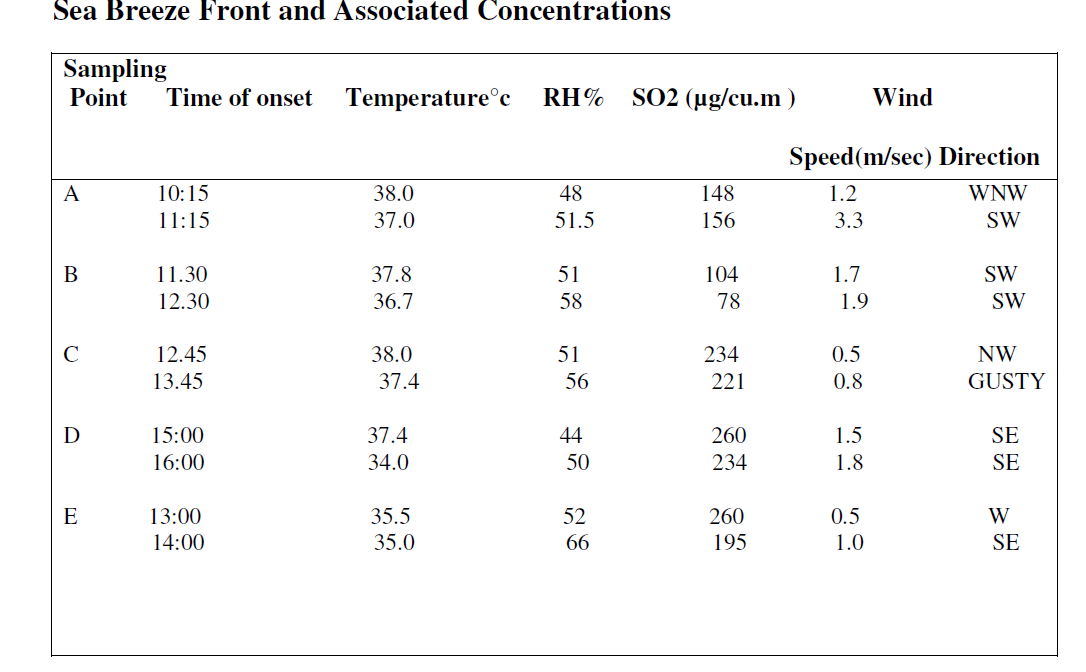ISSN ONLINE(2319-8753)PRINT(2347-6710)
ISSN ONLINE(2319-8753)PRINT(2347-6710)
V.LakshmanaRao1, P.Satish2
|
| Related article at Pubmed, Scholar Google |
Visit for more related articles at International Journal of Innovative Research in Science, Engineering and Technology
On coastal environments, the pollution potential is mainly governed by the land sea breeze circulations. A simulation experiment was carried out by taking the temperature difference (Tland-Tocean) and the resulting circulation acceleration (dv/dt) was also estimated. The influence of sea breeze on local air quality was observed by selecting SO2 as a reference species at different points of Visakhapatnam. The relative meteorological parameters like temperature, relative humidity, wind speed and direction and the resultant SO2 concentrations were observed. A typical ‘sea breeze day’ was studied and the observations were presented in this study. At different points of the study area, the onset time of sea breeze front and the related meteorological parameters were also observed along with SO2 concentrations. The air pollutant concentrations of typical pollutant, SO2, at different sampling points were measured round the clock. Simultaneously measurements of wind vector, relative humidity, temperature and the concentration of SO2 was also observed. In this article we study a characteristic of the sea breeze fronts with regards to the inland moments are attempted and their role in local air quality is also discussed
Keywords |
| Sea breeze front, Land and Sea breeze, coastal environment |
I.INTRODUCTION |
| Land and Sea breezes are the most commonly observed meso scale local wind systems on coastal zones. It has great influence on local weather and plays a crucial role in coastal zone management. The meso scale local circulations due to differential heating of land and ocean surfaces. Further, in region with complex terrain, local wind patterns can develop because of the differential heating between the ground surface and the free atmosphere and same elevation some distance away. The dispersion mechanism of pollutants in coastal zones is mainly influenced by land-sea breeze circulations. The flushing action caused by local circulation result in dilution of air pollutants. Air pollution in any urban center is considered as consisting of point sources (industries), Line sources (vehicular traffic) and Area sources (domestic burnings, combination of both point and line sources). The concentrations mainly depend on the strength of the above mentioned sources. It is established fact now that the meteorology has a profound influence on the dispersion, dilution and oscillation of air pollutants like sulfur dioxide (Sox), oxides of nitrogen (NOx), and total suspended particulate matter (TSP). Observational studies at Visakhapatnam the onshore flow extends to a night of about 1km during the summer and about 700-800m during the post monsoon season. The formation and growth of a land breeze is quite similar to the formation of sea breeze circulations. |
| A study on the distribution of the time of onset and cessation of sea breeze shows that there is marked shift in the time of onset of sea breeze at Visakhapatnam is between 0930 IST and 1130 IST. The most probable time however is between 1000 IST and 1100 IST during summer. Time of cessation of sea breeze less marked and has a broad distribution, most likely time being between 1800 IST 2200 IST. It is very difficult to speak of seasonal variation in the cessation time. Early with drawl of sea breeze has been suggested to be associated with thunder storms which are common during the monsoon season. The duration of the sea breeze is not the same throughout the year and is about 8-10 hours. The sea breeze attains maximum speed generally in the afternoon. The time of onset of sea breeze is determined based on the following consideration: |
| A marked shift in wind direction from offshore (70°-190°) to onshore flow (200°-60°). As the city was almost has a boundary (nearly three sides) by the sea. |
| Change in sign from negative to positive of sea breeze component (SBC) of wind computed from the component of the horizontal wind normal to the sea coast at Visakhapatnam. |
| The onset of sea breeze is simultaneously marked by a change in temperature and / or relative humidity |
II. Data and Methodology |
| Using Kelvin’s circulation theorem, to consider a simplified version of the problem, Holton (1972) shows that there is acceleration in the surface wind at land- sea interface. |
| dv/dt= R ln (Po/Po)/2 (h+L) (Tl-Ts) |
| This is the equation for the circulation acceleration (dv/dt). R is the universal gas constant P0, P1 pressure at surface and some elevation, Tl-Ts (ΔT) is the temperature difference between land and sea water, h is the height of the concerned volume (grid) L is the length of the observed area. Simulation experiment was conducted for all four seasons by varying the Tl-Ts. The resultant dv/dt was presented in the table. |
| Let us assume Po is 100 Kpa, P1 is 90 Kpa, Tl-Ts is 10⁰c, L is 20km and h is 1km.Then dv/dt is 7.19x103ms-2. From, the equation for a fixed observational grid, [ln (Po/P1)/2(h+l)] will become constant. |
| Therefore dv/dt is directly proportional to the differential heating (ΔT) of land and sea (Peddiraju and Vittal Murty, 1995). |
| dv/dt α (Tl-Ts) |
| dv/dt = K. ΔT |
| Where K is the proportionality constant. By varying ΔT, the resultant dv/dt was estimated. The seasonal dv/dt was presented in the table. |
| At different points of the study area, the time of sea breeze front and the related meteorological parameters were also observed along with SO2 concentrations and presented in the given below tables. |
| The air pollutant concentrations of typical pollutant, SO2, at different sampling points were measured round the clock. Simultaneously measurements of wind vector, relative humidity, temperature and the concentration of SO2 was also observed with advent of sea breeze front indicates a brisk increase of the concentrations SO2 except the points A & B. A close observation of the data reveals that this fact can be explained from the wind direction observations. For example: at point A the concentrations are relatively low with the advent of sea breeze as the wind is pre dominantly NW to SE which clearly indicates that the pollutants from industrial sources are carried away from the sampling point as a result the concentrations are 148 μg/m3 . This also indicates that these concentrations are closely related with traffic but not to industrial pollution. The sampling points B is very near to a major industry, however, the relative concentration is related to the source variations. |
III. Results and Discussions |
| One of the dominant features of the local circulation of Visakhapatnam is the persistent sea breeze during day time and the land breeze during night time almost throughout the year. Very often changes are seen in temperature, wind vector, and water vapor pressure (Humidity) associated with these circulations. The sharp rise in temperature after sunrise is very often followed by sudden wind direction change, drop in temperature and increase in humidity. These features marked the onset of sea breeze. The sea breeze has very less impact on the point B. The sampling points C &D are marked by rapid increase in the concentration with the advent of sea breeze front, the wind direction is form the industrial area so the pollutants are easily carried towards the sampling points and the relative increase in wind speed promotes the concentration. In the case of point C which is very near to Yarada Hills, the concentration can increase even from the reflections from the hill that is even if wind direction is slightly to the south of the sampling point. The sampling point E also shows an increase in concentration depending on wind direction even though, it is slightly far away from the industrial source. In a nut shell the sea breeze influenced markedly the concentration of air pollutants of industrial origin at various sampling points. We can conclude that .The intensity of sea breeze is more than the land breeze. It was also observed that there are concentrations at sampling points as far as 15 to 20 km from source points, which are not in the down wind direction do not show any increase because of sea breeze front. |
IV.CONCLUSIONS |
| Flushing action of air pollutants due to local circulations was estimated and explained in this chapter. Special emphasis was given to sea/land breeze circulations. The characteristics of sea breeze were presented. The sea breeze index (σ) was estimated and shows that σ has inverse proponality with the possibility of occurrence of intense sea breeze event. Simultaneously measurements of wind vector, relative humidity, temperature and the concentration of SO2 was also observed. In this article we study a characteristic of the sea breeze fronts with regards to the inland moments are attempted and their role in local air quality is also discussed. The intensity of sea breeze is more than the land breeze. It was also observed that there are concentrations at sampling points as far as 15 to 20 km from source points, which are not in the down wind direction do not show any increase because of sea breeze front. |
 |
 |
 |
References |
|